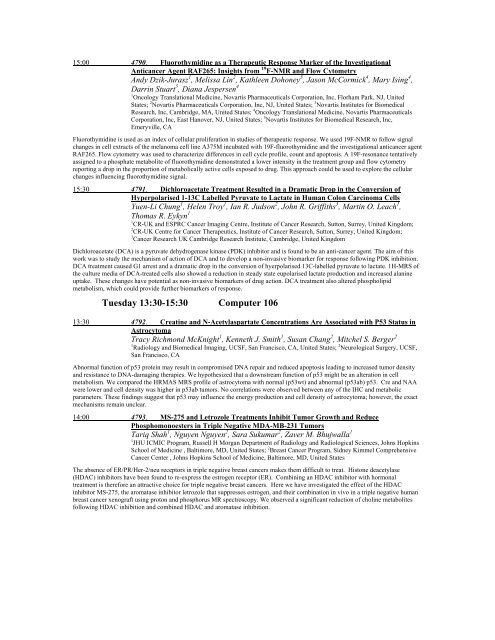ELECTRONIC POSTER - ismrm
ELECTRONIC POSTER - ismrm
ELECTRONIC POSTER - ismrm
Create successful ePaper yourself
Turn your PDF publications into a flip-book with our unique Google optimized e-Paper software.
15:00 4790. Fluorothymidine as a Therapeutic Response Marker of the Investigational<br />
Anticancer Agent RAF265: Insights from 19 F-NMR and Flow Cytometry<br />
Andy Dzik-Jurasz 1 , Melissa Lin 2 , Kathleen Dohoney 3 , Jason McCormick 4 , Mary Ising 4 ,<br />
Darrin Stuart 5 , Diana Jespersen 4<br />
1 Oncology Translational Medicine, Novartis Pharmaceuticals Corporation, Inc, Florham Park, NJ, United<br />
States; 2 Novartis Pharmaceuticals Corporation, Inc, NJ, United States; 3 Novartis Institutes for Biomedical<br />
Research, Inc, Cambridge, MA, United States; 4 Oncology Translational Medicine, Novartis Pharmaceuticals<br />
Corporation, Inc, East Hanover, NJ, United States; 5 Novartis Institutes for Biomedical Research, Inc,<br />
Emeryville, CA<br />
Fluorothymidine is used as an index of cellular proliferation in studies of therapeutic response. We used 19F-NMR to follow signal<br />
changes in cell extracts of the melanoma cell line A375M incubated with 19F-fluorothymidine and the investigational anticancer agent<br />
RAF265. Flow cytometry was used to characterize differences in cell cycle profile, count and apoptosis. A 19F-resonance tentatively<br />
assigned to a phosphate metabolite of fluorothymidine demonstrated a lower intensity in the treatment group and flow cytometry<br />
reporting a drop in the proportion of metabolically active cells exposed to drug. This approach could be used to explore the cellular<br />
changes influencing fluorothymidine signal.<br />
15:30 4791. Dichloroacetate Treatment Resulted in a Dramatic Drop in the Conversion of<br />
Hyperpolarised 1-13C Labelled Pyruvate to Lactate in Human Colon Carcinoma Cells<br />
Yuen-Li Chung 1 , Helen Troy 1 , Ian R. Judson 2 , John R. Griffiths 3 , Martin O. Leach 1 ,<br />
Thomas R. Eykyn 1<br />
1 CR-UK and ESPRC Cancer Imaging Centre, Institute of Cancer Research, Sutton, Surrey, United Kingdom;<br />
2 CR-UK Centre for Cancer Therapeutics, Institute of Cancer Research, Sutton, Surrey, United Kingdom;<br />
3 Cancer Research UK Cambridge Research Institute, Cambridge, United Kingdom<br />
Dichloroacetate (DCA) is a pyruvate dehydrogenase kinase (PDK) inhibitor and is found to be an anti-cancer agent. The aim of this<br />
work was to study the mechanism of action of DCA and to develop a non-invasive biomarker for response following PDK inhibition.<br />
DCA treatment caused G1 arrest and a dramatic drop in the conversion of hyerpolarised 13C-labelled pyruvate to lactate. 1H-MRS of<br />
the culture media of DCA-treated cells also showed a reduction in steady state eupolarised lactate production and increased alanine<br />
uptake. These changes have potential as non-invasive biomarkers of drug action. DCA treatment also altered phospholipid<br />
metabolism, which could provide further biomarkers of response.<br />
Tuesday 13:30-15:30 Computer 106<br />
13:30 4792. Creatine and N-Acetylaspartate Concentrations Are Associated with P53 Status in<br />
Astrocytoma<br />
Tracy Richmond McKnight 1 , Kenneth J. Smith 1 , Susan Chang 2 , Mitchel S. Berger 2<br />
1 Radiology and Biomedical Imaging, UCSF, San Francisco, CA, United States; 2 Neurological Surgery, UCSF,<br />
San Francisco, CA<br />
Abnormal function of p53 protein may result in compromised DNA repair and reduced apoptosis leading to increased tumor density<br />
and resistance to DNA-damaging therapies. We hypothesized that a downstream function of p53 might be an alteration in cell<br />
metabolism. We compared the HRMAS MRS profile of astrocytoma with normal (p53wt) and abnormal (p53ab) p53. Cre and NAA<br />
were lower and cell density was higher in p53ab tumors. No correlations were observed between any of the IHC and metabolic<br />
parameters. These findings suggest that p53 may influence the energy production and cell density of astrocytoma; however, the exact<br />
mechanisms remain unclear.<br />
14:00 4793. MS-275 and Letrozole Treatments Inhibit Tumor Growth and Reduce<br />
Phosphomonoesters in Triple Negative MDA-MB-231 Tumors<br />
Tariq Shah 1 , Nguyen Nguyen 2 , Sara Sukumar 2 , Zaver M. Bhujwalla 1<br />
1 JHU ICMIC Program, Russell H Morgan Department of Radiology and Radiological Sciences, Johns Hopkins<br />
School of Medicine , Baltimore, MD, United States; 2 Breast Cancer Program, Sidney Kimmel Comprehensive<br />
Cancer Center , Johns Hopkins School of Medicine, Baltimore, MD, United States<br />
The absence of ER/PR/Her-2/neu receptors in triple negative breast cancers makes them difficult to treat. Histone deacetylase<br />
(HDAC) inhibitors have been found to re-express the estrogen receptor (ER). Combining an HDAC inhibitor with hormonal<br />
treatment is therefore an attractive choice for triple negative breast cancers. Here we have investigated the effect of the HDAC<br />
inhibitor MS-275, the aromatase inhibitor letrozole that suppresses estrogen, and their combination in vivo in a triple negative human<br />
breast cancer xenograft using proton and phosphorus MR spectroscopy. We observed a significant reduction of choline metabolites<br />
following HDAC inhibition and combined HDAC and aromatase inhibition.
















